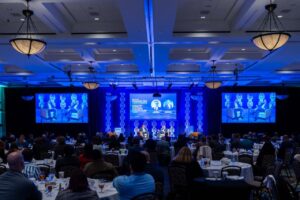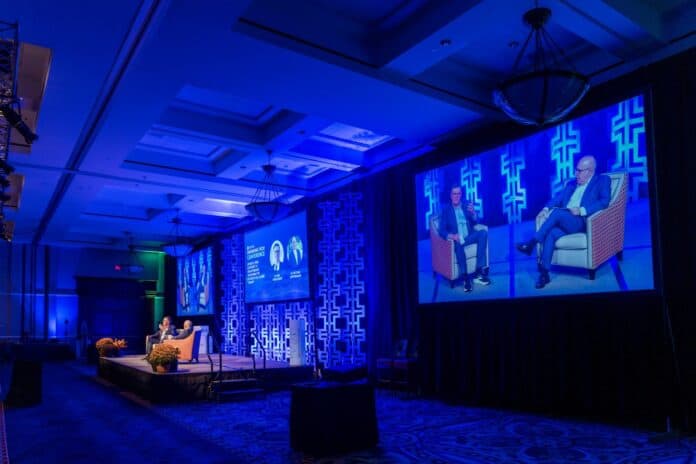Leaders from Children’s National Hospital and the Fralin Biomedical Research Institute at VTC detailed plans to grow their collaboration and speed pediatric innovations from the lab to clinical care during the recent Roanoke-Blacksburg Technology Council Emerging Tech Conference.
The partnership connects two of Virginia’s leading biomedical hubs — a nationally ranked and globally recognized children’s hospital in Washington, D.C., and a major Virginia Tech research institute — in a shared effort to turn discoveries into treatments that reach young patients faster.
It also reflects a statewide goal: linking the research and innovation ecosystems in the greater Washington, D.C., area and Southwest Virginia.
Nate Kuppermann, chief academic officer and chair of pediatrics at Children’s National, said research collaboration is essential to raising the standard of care for children everywhere.
“We have to develop the best care not just for children in our region, but for children everywhere,” Kuppermann said. “To elevate care, you have to work collaboratively.”
A pediatric emergency physician by training, Kuppermann built national and global research networks during his tenure at UC Davis before joining Children’s National.
He said those experiences shaped his belief that the most meaningful advances come from partnerships that connect academic medicine, industry, and engineering.
Michael Friedlander, executive director of the Fralin Biomedical Research Institute at VTC and Virginia Tech’s vice president for health sciences and technology, said the selfsame collaborative spirit has defined Roanoke’s transformation into a growing biomedical hub.
“Innovation is what we are about,” Friedlander said. “We do all the traditional academic things — research, teaching, publishing — but we also believe deeply in moving discoveries out of the lab and to patients.”
When the institute opened 15 years ago, the region had far less startup or venture infrastructure, he said. Today, thanks to programs supported by Virginia Tech’s LAUNCH center, the Roanoke Blacksburg Innovation Alliance (RBIA), and the VTC Ventures Fund , researchers can advance discoveries from early concept to commercial product.
“This area is moving fast,” Friedlander said. “With support from the state and strong community partnerships, the full innovation pipeline is taking shape.”

Linking science and patient care
Both leaders highlighted focused ultrasound and artificial intelligence (AI) as areas where their institutions already intersect.
Virginia Tech has a history in focused ultrasound research and innovation — a noninvasive technology that uses targeted sound waves to deliver energy deep within the body, including into the brain. Researchers in Roanoke are exploring both high-intensity methods that destroy tumors and low-intensity techniques that can modulate brain activity or temporarily open the blood-brain barrier to allow therapeutic anti-cancer drugs to reach tumors.
Children’s National is using similar technology to treat pediatric brain cancers and open the blood-brain barrier, and both organizations are Focused Ultrasound Centers of Excellence. A jointly appointed physician-scientist, Fred Wu, is an assistant professor with the Fralin Biomedical Research Institute at VTC and at the Children’s National Brain Tumor Institute who works across both sites, linking clinical patient applications in Washington, D.C., with biomedical research.
Artificial intelligence is another bridge between the institutions. At Virginia Tech’s Sanghani Center for Artificial Intelligence and Data Analytics in Alexandria and Blacksburg, computer scientists and engineers are developing AI tools that are being applied to medicine, including pediatric research and hospital operations.
Personalized, cell-based treatments
At Children’s National, AI is already improving access to care in low-resource settings. In Malawi, clinicians are using handheld ultrasound paired with AI algorithms to diagnose rheumatic heart disease, and low-field MRI enhanced with machine learning to detect cerebral malaria — approaches that could inform similar efforts in rural U.S. communities.
“These are examples of how we can take what we’re learning through basic and translational research at our innovative institutes, and apply it directly to patient care,” Kuppermann said.
In addition, Kuppermann and Friedlander underscored cellular and genetic therapies as a transformative frontier in modern medicine. These therapies use a patient’s own cells that have been re-engineered to recognize and attack their tumors or apply gene editing technologies to repair disease-causing genetic sequences to correct or combat disease at its source.
Recently, at the third annual Cell and Gene Therapy Symposium in Washington, D.C., Catherine Bollard, senior vice president and chief research officer at Children’s National and director of its Center for Cancer and Immunology Research, and Patrick Hanley, chief and director of the Cellular Therapy Program, led discussions on advancing these therapies and improving the manufacturing of personalized, cell-based treatments for children. The symposium was supported by CHARM – the Capital Health and Mid-Atlantic Regenerative Medicine initiative.
“It is exciting to have the opportunity to collaborate with our Children’s National colleagues who are established leading innovators in this space on advancing these technologies,” Friedlander said.
Such treatments are already reshaping care for certain cancers and genetic disorders like sickle cell disease. Researchers at Children’s National have pioneered these methods for children, and Friedlander said expanding these capabilities through partnerships could help make them accessible to more patients over a broader region.
“These are transformative advances in medicine,” Kuppermann said. “Our colleagues at Children’s National are already delivering them to patients, and together we can help ensure more children have access to the same life-changing opportunities.”

Expanding research impact
The leaders framed their collaboration as part of a broader strategy linking the Washington, D.C.’s pediatric clinical and research efforts with Southwest Virginia’s growing research and commercialization base.
“The future is very bright,” Friedlander said. “Partnerships like these will allow us to bring our best science to serve children and families — here in Virginia and around the world.”
The talk concluded with a surprise recognition for Friedlander’s 15 years of leadership.
Roanoke Mayor Joe Cobb, joined by City Manager Valmarie Turner and Director of Economic Development Marc Nelson, presented a proclamation declaring Oct. 30 as Dr. Michael Friedlander Day in Roanoke.
Cobb said that when he moved to the city 24 years ago, the area around Carilion Roanoke Memorial Hospital looked very different.
“If you were to see what it was like then and what it is today, you might say a miracle has occurred,” Cobb said. “One of the people who has played a significant role in that miracle is Dr. Mike Friedlander.”
Turner cited the institute’s $1.7 billion economic impact over 15 years — including $90 million in the past year alone — as evidence of Friedlander’s success in turning “a leap of faith into an economic and scientific engine that now defines this region’s future.”
The proclamation said Friedlander transformed the institute from “a single office to a thriving community of more than 700 faculty, students, and staff” leading research in cancer, neuroscience, and cardiometabolic health, while fostering a welcoming culture for new faculty and families.
As the institute prepares to open the Virginia Tech Patient Research Center in Roanoke, the proclamation read, Friedlander’s vision “continues to inspire the next generation of scientists, innovators, and community partners.”
By John Pastor


